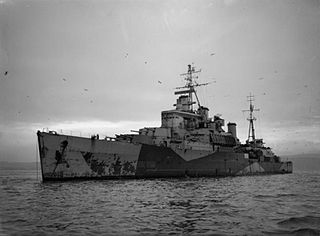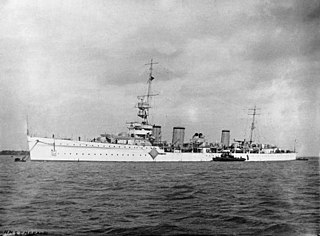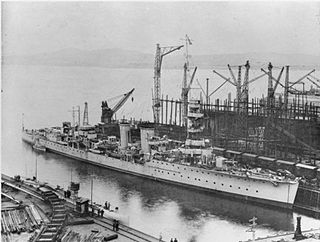
HMS Cairo (D87) was a C-class light cruiser of the Royal Navy, named after the Egyptian capital, Cairo. So far she has been the only ship of the Royal Navy to bear the name. She was part of the Carlisle group of the C-class of cruisers.

HMS Cardiff was a C-class light cruiser built for the Royal Navy during World War I. She was one of the five ships of the Ceres sub-class and spent most of her career as a flagship. Assigned to the Grand Fleet during the war, the ship participated in the Second Battle of Heligoland Bight in late 1917. Cardiff was briefly deployed to the Baltic in late 1918 supporting anti-Bolshevik forces during the British campaign in the Baltic during the Russian Civil War.

The Fiji-class cruisers were a class of eleven light cruisers of the Royal Navy that saw extensive service throughout the Second World War. Each ship of the class was named after a Crown colony or other constituent territory of the British Commonwealth and Empire. The class was also known as the Colony class, or Crown Colony class. Developed as more compact versions of the preceding Town-class cruisers, the last three were built to a slightly modified design and were sometimes also called the Ceylon class.

HMS Jamaica, a Fiji-class cruiser of the Royal Navy, was named after the island of Jamaica, which was a British Crown Colony when she was built in the late 1930s. The light cruiser spent almost her entire wartime career on Arctic convoy duties, except for a deployment south for the landings in North Africa in November 1942. She participated in the Battle of the Barents Sea in 1942 and the Battle of North Cape in 1943. Jamaica escorted several aircraft carriers in 1944 as they flew off airstrikes that attacked the German battleship Tirpitz in northern Norway. Late in the year she had an extensive refit to prepare her for service with the British Pacific Fleet, but the war ended before she reached the Pacific.

HMS Royal Sovereign was a Revenge-class battleship of the Royal Navy displacing 29,970 long tons (30,451 t) and armed with eight 15-inch (381 mm) guns in four twin-gun turrets. She was laid down in January 1914 and launched in April 1915; she was completed in May 1916, but was not ready for service in time to participate in the Battle of Jutland at the end of the month. She served with the Grand Fleet for the remainder of the First World War, but did not see action. In the early 1930s, she was assigned to the Mediterranean Fleet and based in Malta.

HMS Mauritius, pennant C80, was a Fiji-class light cruiser of the Royal Navy. The ship was built by Swan Hunter, Newcastle upon Tyne. She was named after Mauritius, which was a British colony when she was built and entered service in 1941.

HMS Newfoundland was a Fiji-class light cruiser of the Royal Navy. Named after the Dominion of Newfoundland, she participated in the Second World War and was later sold to the Peruvian Navy.

The C class was a group of twenty-eight light cruisers of the Royal Navy, and were built in a sequence of seven groups known as the Caroline class, the Calliope class, the Cambrian class, the Centaur class, the Caledon class, the Ceres class and the Carlisle class. They were built for the rough conditions of the North Sea, and proved to be rugged and capable vessels, despite being somewhat small and cramped.

HMS Arethusa was the name ship of her class of light cruisers built for the Royal Navy. She was built by Chatham Dockyard, with the keel being laid down on 25 January 1933. She was launched on 6 March 1934, and commissioned 21 May 1935 by Captain Philip Vian.

HMS Sussex was one of the London sub-class of the County-class heavy cruisers in the Royal Navy. She was laid down by R. and W. Hawthorn, Leslie and Company, Limited, at Hebburn-on-Tyne on 1 February 1927, launched on 22 February 1928 and completed on 19 March 1929.

HMS Black Prince was a Dido-class light cruiser of the Royal Navy, of the Bellona subgroup. The cruiser was commissioned in 1943, and served during World War II on the Arctic convoys, during the Normandy landings, and as part of the British Pacific Fleet. In 1946, the cruiser was loaned to the Royal New Zealand Navy, becoming HMNZS Black Prince. The cruiser was docked for modernisation in 1947, but in April, her sailors walked off the ship as part of a series of mutinies in the RNZN. The shortage of manpower resulting from these mutinies meant that the modernisation had to be cancelled, and Black Prince was placed in reserve until 1953. She returned to service after refitting with simplified secondary armament with a single quad "pom pom" in Q position and eight Mk3 40mm Bofors guns. The ship was decommissioned again two years later, and returned to the Royal Navy in 1961. Black Prince did not re-enter service, and was towed from Auckland to Osaka for scrapping in 1962.

HMS York was the lead ship of her class of two heavy cruisers built for the Royal Navy in the late 1920s. She mostly served on the North America and West Indies Station before World War II. Early in the war the ship escorted convoys in the Atlantic and participated in the Norwegian Campaign in 1940. York was transferred to the Mediterranean theatre in late 1940 where she escorted convoys and the larger ships of the Mediterranean Fleet. She was wrecked in an attack by Italian explosive motorboats of the 10th Flotilla MAS at Suda Bay, Crete, in March 1941. The ship's wreck was salvaged in 1952 and subsequently scrapped.

HMS Cleopatra was a Dido-class cruiser of the Royal Navy. She was built by R. and W. Hawthorn, Leslie and Company, Limited, with the keel being laid down on 5 January 1939. She was launched on 27 March 1940, and commissioned on 5 December 1941.

The Emerald class or E class was a class of two light cruisers built for the Royal Navy. Following the Cavendish class, three ships of a new class were ordered in March 1918, towards the end of World War I, designed to emphasise high speed at the cost of other qualities, for use against rumoured new high-speed German cruisers – like the Brummer class – and particularly minelayers, in the North Sea. The third ship was cancelled in November 1918.

HMS Sirius was a Dido-class light cruiser of the Royal Navy. She was built by Portsmouth Dockyard, with the keel being laid down on 6 April 1938. She was launched on 18 September 1940, and commissioned 6 May 1942.

HMS Bermuda was a Fiji-class light cruiser of the Royal Navy. She was completed during World War II and served in that conflict. She was named for the British territory of Bermuda, and was the eighth vessel of that name.

HMS Southampton was a member of the first group of five ships of the Town class of light cruisers. She was built by John Brown & Company, Clydebank, Scotland and launched on 10 March 1936.

HMS Active, the tenth Active, launched in 1929, was an A-class destroyer. She served in the Second World War, taking part in the sinking of four submarines. She was broken up in 1947.

HMS Carlisle was a C-class light cruiser of the Royal Navy, named after the English city of Carlisle. She was the name ship of the Carlisle group of the C-class of cruisers. Carlisle was credited with shooting down eleven Axis aircraft during the Second World War and was the top scoring anti-aircraft ship in the Royal Navy.

HMS Caradoc was a C-class light cruiser built for the Royal Navy during World War I. She was one of the four ships of the Caledon sub-class. Assigned to the Grand Fleet during the war, the ship participated in the Second Battle of Heligoland Bight in late 1917. Caradoc was briefly deployed to the Baltic in late 1918 supporting anti-Bolshevik forces during the British campaign in the Baltic and then was transferred to the Mediterranean Fleet in early 1919 and spent the next year and a half doing the same thing in the Black Sea during the Russian Civil War. The ship was withdrawn from the Black Sea in mid-1920 to observe the Greco-Turkish War of 1919–22 and the Chanak Crisis of late 1922. Caradoc spent most of the rest of her time between the World Wars overseas or in reserve with deployments to the Far East and the North America and West Indies Station.






















